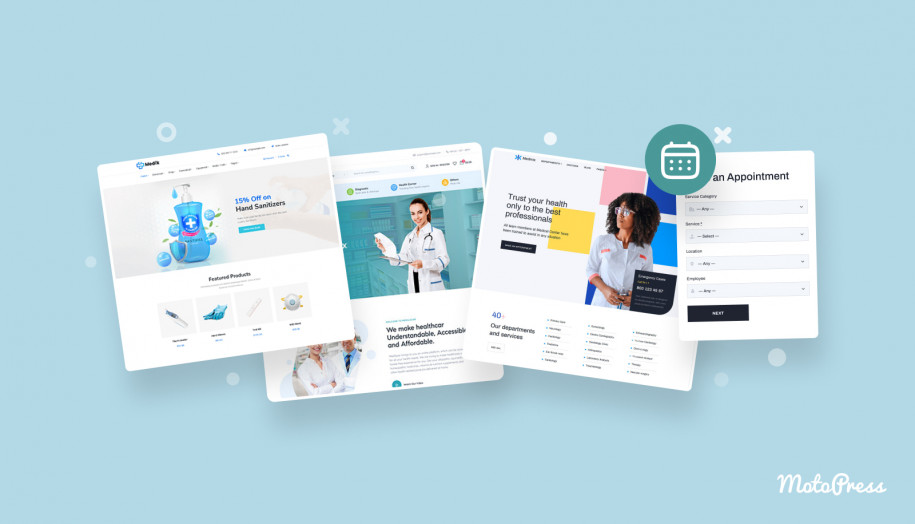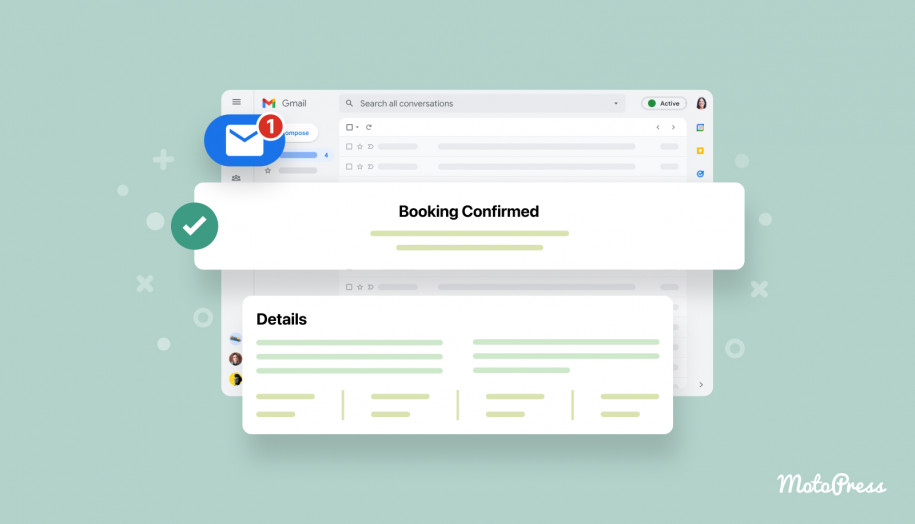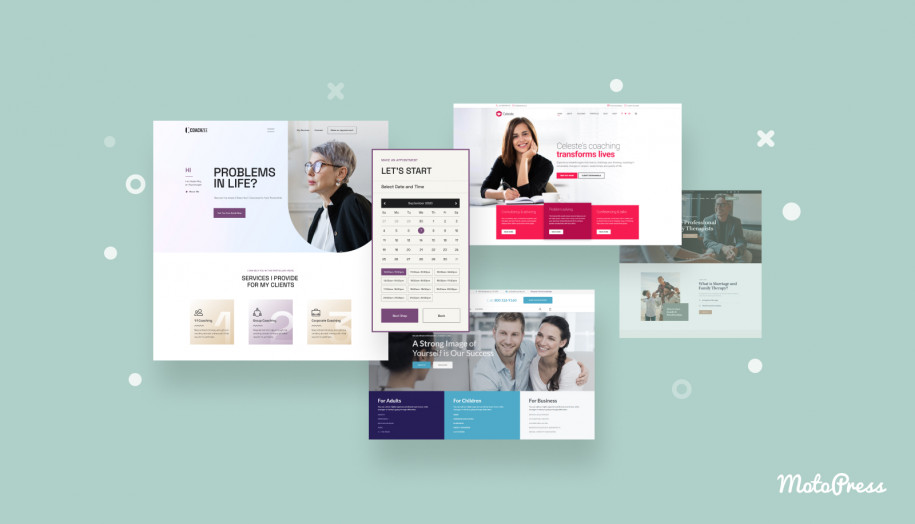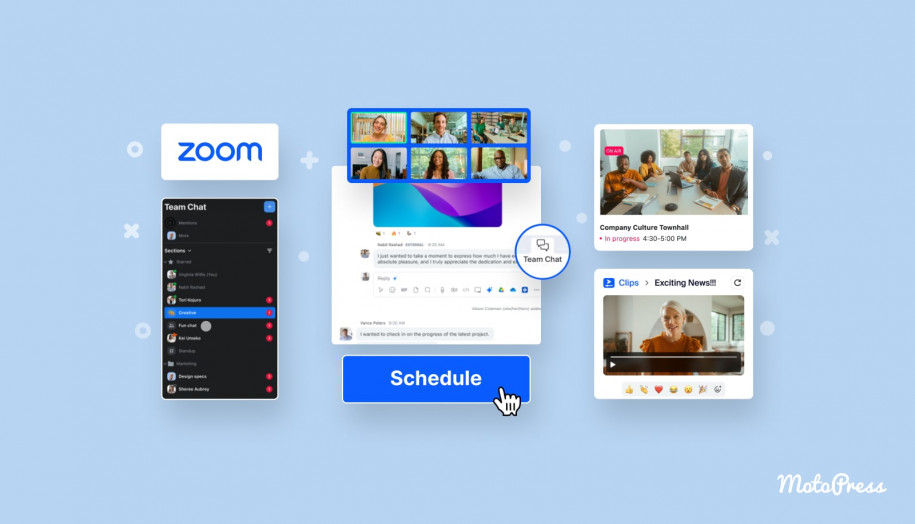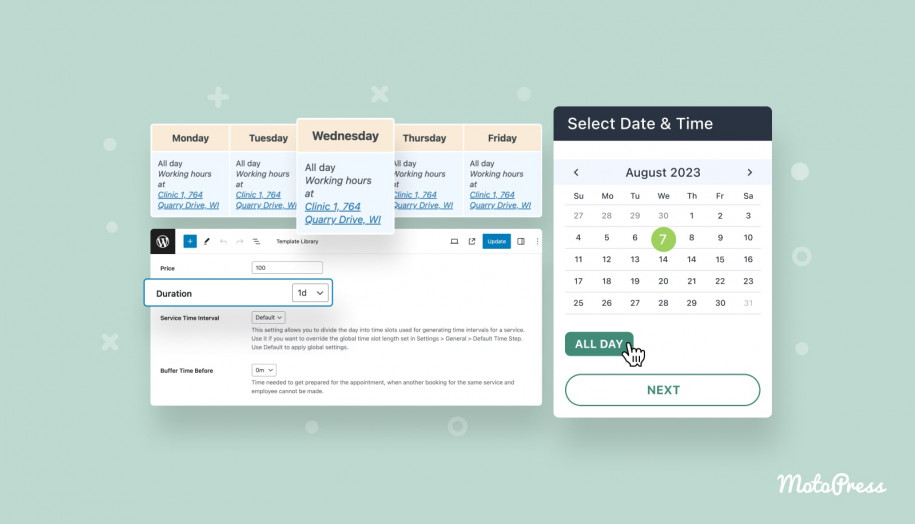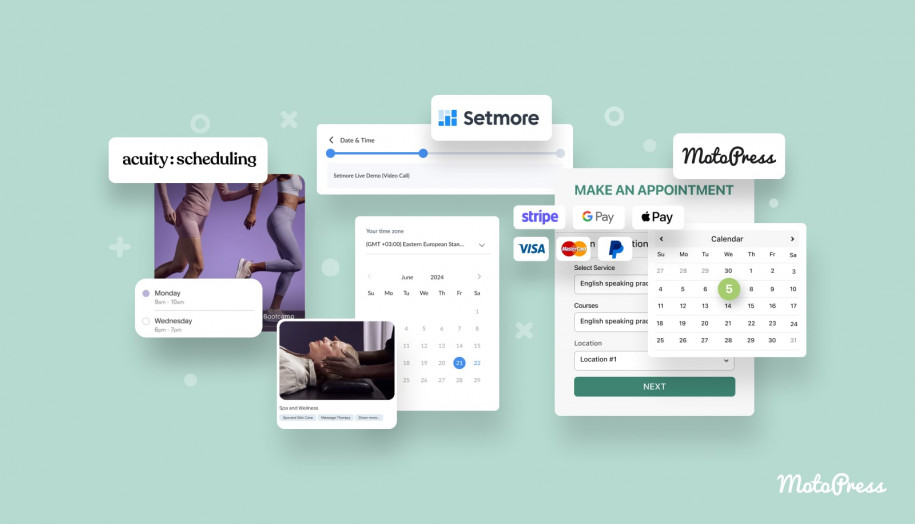10+ Strategies to Increase Patient Retention Rate
Table of Contents
Looking for patient retention ideas? There is a common observation that it is often better and sometimes easier to build good relationships with existing clients than to attract new ones. This aspect is particularly significant in niches like medical services where people are always interested in improving and maintaining their health.
For instance, when faced with a choice of purchasing a new dress, oven, or table while simultaneously experiencing health issues, it’s evident that individuals will opt to pay for services that can alleviate their pain rather than spend that money on entertainment or goods.
Regarding the subject of our article, for start, let’s delve deeper into the question of what is patient retention rate. It’s easy to deduce that this metric is a rate indicating how well your clients are retained or how effective your business is at converting initially attracted clients into continuous customers. This rate is often calculated by tracking the number of returning customers and comparing it to the total patient base.
For instance, statistical data from Forbes highlights the importance of building a good relationship with patients by providing the following figures:
The probability of your existing patients visiting your practice for healthcare services is 60%-70%. For new patients, the likelihood is 5%-20%.
Through a variety of methods like bolstering engagement, enhancing communication, and delivering high-quality healthcare services, medical practices aim to improve patient retention rate, ensuring a stable clientele and, consequently, a sustainable and flourishing healthcare business. In the following sections, we unveil eleven strategies to help you answer the question, “How to increase patient retention?” and transform your clients into returning customers.
1. Personalized and Respectful Patient Communication
Let me begin with a personal story. Some time ago, I sought care at a highly reputable clinic. During the visit, while discussing the symptoms with the doctor, the response received was rather offensive. Without delving into the specifics of the conversation, the crux of the matter was that the physician found it amusing and odd that such a disease was brought to his attention. He further implied that had certain actions been taken — actions that were actually outside my capability — the issue wouldn’t have arisen. In essence, the doctor pointed out my personal inabilities, making the experience highly unpleasant.
To put it even more simply, if this dialogue had occurred in an Irish pub, it would have been appropriate to respond to the doctor’s remarks with a punch to the face. However, the setting was not an Irish pub, and given the distress and depression I was experiencing due to my issue at the time, such a reaction, though possibly warranted under other circumstances, was not an option. Before this incident, I frequented this clinic whenever the need arose. However, following this situation, I resolved never to return to this medical institution again.
The moral of the story is that it’s of the utmost importance to employ individuals in your medical institution who are extremely polite and respectful. Regardless of a doctor’s experience and qualifications, it’s inappropriate to mock patients or make offensive remarks, especially when they are vulnerable. While this point may seem self-evident, reality has shown that even some reputable clinics may have inadequate personnel.
To be more precise, here are the key aspects that should be embodied in your institution if you aim to convert your clients into regular patients, and ultimately increase a patient retention rate. Some points will be presented as “general” recommendations, while others will be directed towards doctors personally. So, if you are a business owner, it would be ideal to seek and hire individuals who meet these conditions:
- It is crucial to understand a patient’s condition and their subsequent emotional state. People visit clinics primarily not for fun or enjoyment, but usually due to pressing health concerns. Even if the issue isn’t urgent, it’s important to comprehend the reasons that led them to seek medical assistance.
No matter how cliché it may sound, being able to put yourself in the patient’s shoes, or at least displaying understanding and compassion is vital. This can be achieved by listening more and speaking less, using supportive words, and avoiding any inappropriate comments. - Extend the dialogue even after the visit. This action serves not only as a thoughtful gesture but also as an opportunity to check on the patient’s health progress and offer any further guidance. It underscores your care and invites feedback, fostering a two-way engagement.
In other words, you can simply track the results of the treatment to see whether your recommendations yielded the desired outcomes or if they didn’t work as expected. - Transparent communication about treatment plans, costs, and what to expect during visits is a cornerstone of the patient retention rate increase. Being forthright about these aspects helps in aligning expectations and building a foundation of trust, which is indispensable for a lasting patient-practitioner relationship.
- Upholding the sanctity of privacy and confidentiality in all communications is not merely a regulatory requisite but also another trust-building factor. It underscores a sense of respect and assurance in the medical rapport, which is pivotal for a rewarding healthcare experience.
2. Utilizing Technology: Appointment Scheduling, Personalized Reminders, and Follow-ups
We live in an age where everything, from child diapers to airplanes and factories, is showcased, sold, and bought via the Internet. The medical services niche is no exception. Therefore, apart from media coverage, it is crucial to have a professional-looking website equipped with all the essential features for clinics. The most evident and critical functionality is appointment scheduling.
Yes, nowadays, most appointments for medical services are scheduled via websites, social networks, or messengers. Phone calls have become less popular over time. So, how to increase patient retention rate through technology utilization? To enable customers to smoothly book an appointment with the medical practitioner of their desired specialization, it is vital to offer them this opportunity through appropriate software via the web.
A prime example of such a digital solution is the Appointment Booking plugin from MotoPress. We will review some features that are essential for medical institutions and are present in this tool. For illustration, we will examine the capabilities of the extension using the corresponding WordPress template for medical institutions, namely Medmix, as an example:
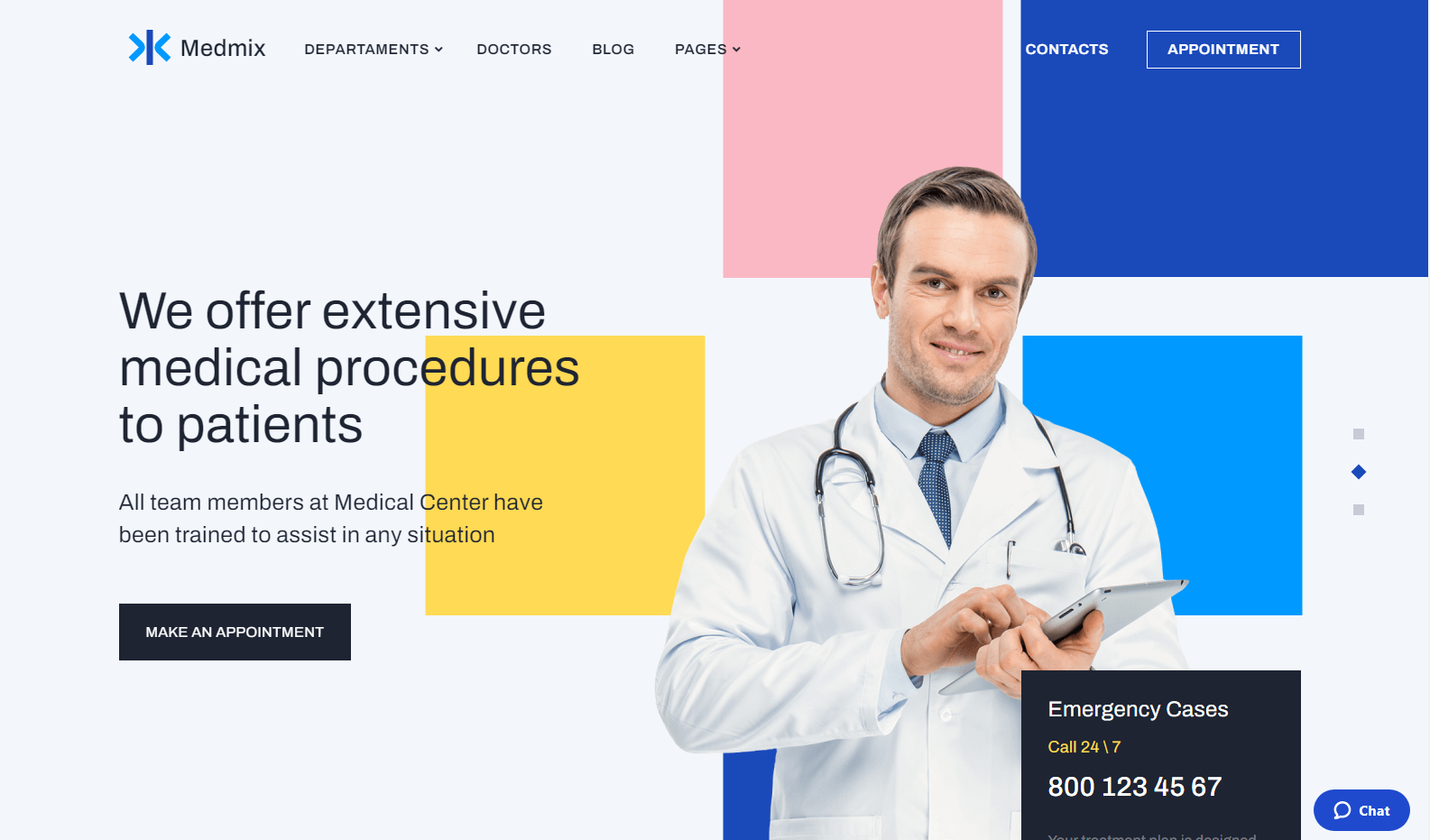
So, what functionalities should a proper modern medical website offer?
Well-Presented Services and Locations
If you have several branches, it’s evident that all of them should be featured on your website. Even if you currently offer certain services in only one location, with appropriate management, there’s nothing to stop you from expanding your business.
Additionally, you could consider partnering with other clinics to list them on your website. The main point here is that the technical solution you choose for your online presence should not limit the number of services and locations you can list. Medmix, combined with the Appointment Booking plugin, offers exactly that: the flexibility to list unlimited services and locations on your site.
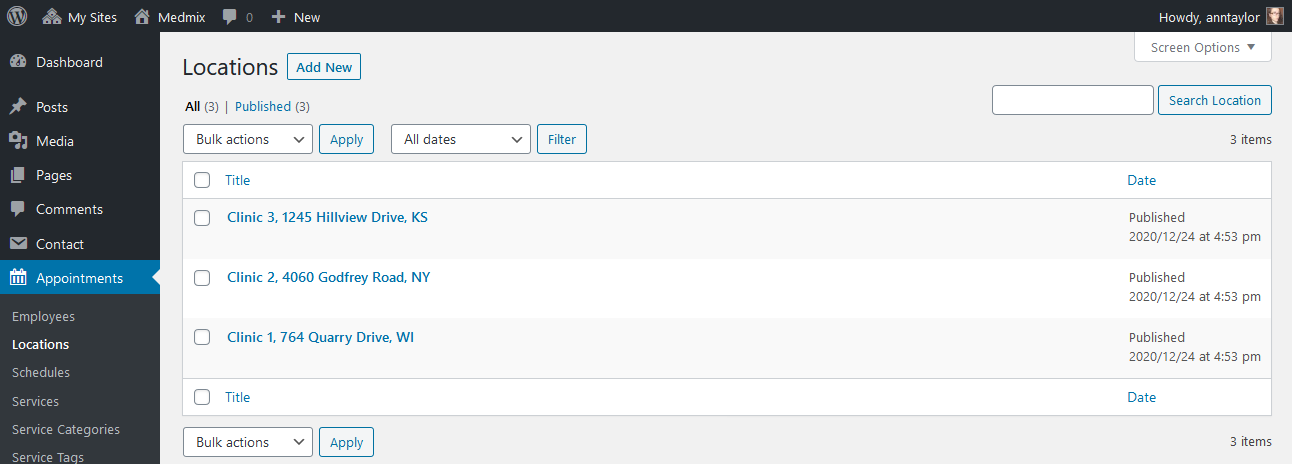
Practitioners and Their Expertise
By listing all staff members along with their specializations, you provide a transparent and informative platform for patients to choose the right practitioner for their needs. Medmix, along with the corresponding plugin included with the template for free, allows you to showcase essentially unlimited staff members.
The listing of team members for website visitors will look like this:

While the corresponding admin area appears as follows:
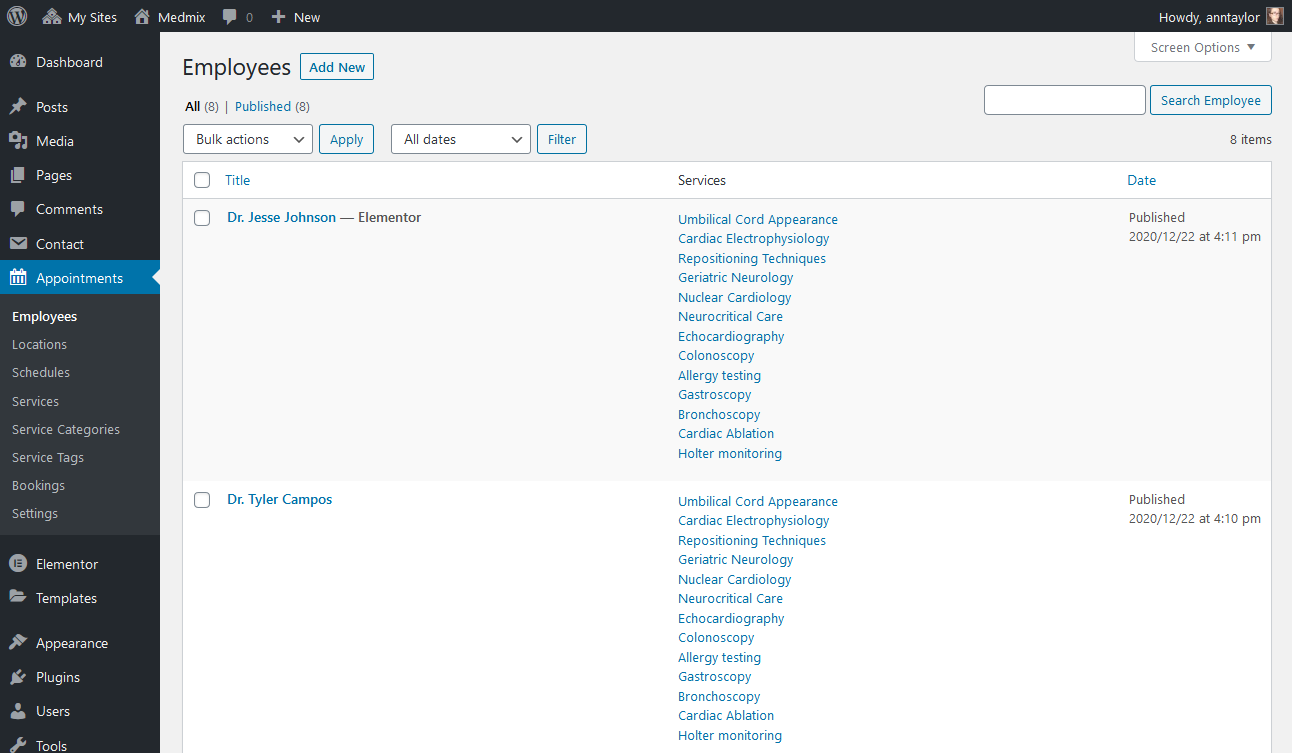
Flexible Personal Schedule
Another important aspect is the ability to adjust the schedule of each medical specialist according to their preferences. Unlike cases where all team members have identical time slots, Medmix provides a flexible scheduling system.
Individual working day plans for each doctor can be created, including breaks, lunchtimes, days off, and vacations. This ensures that bookings are always aligned with the availability of the medical staff, preventing overbooking and ensuring the smooth operation of the healthcare facility.
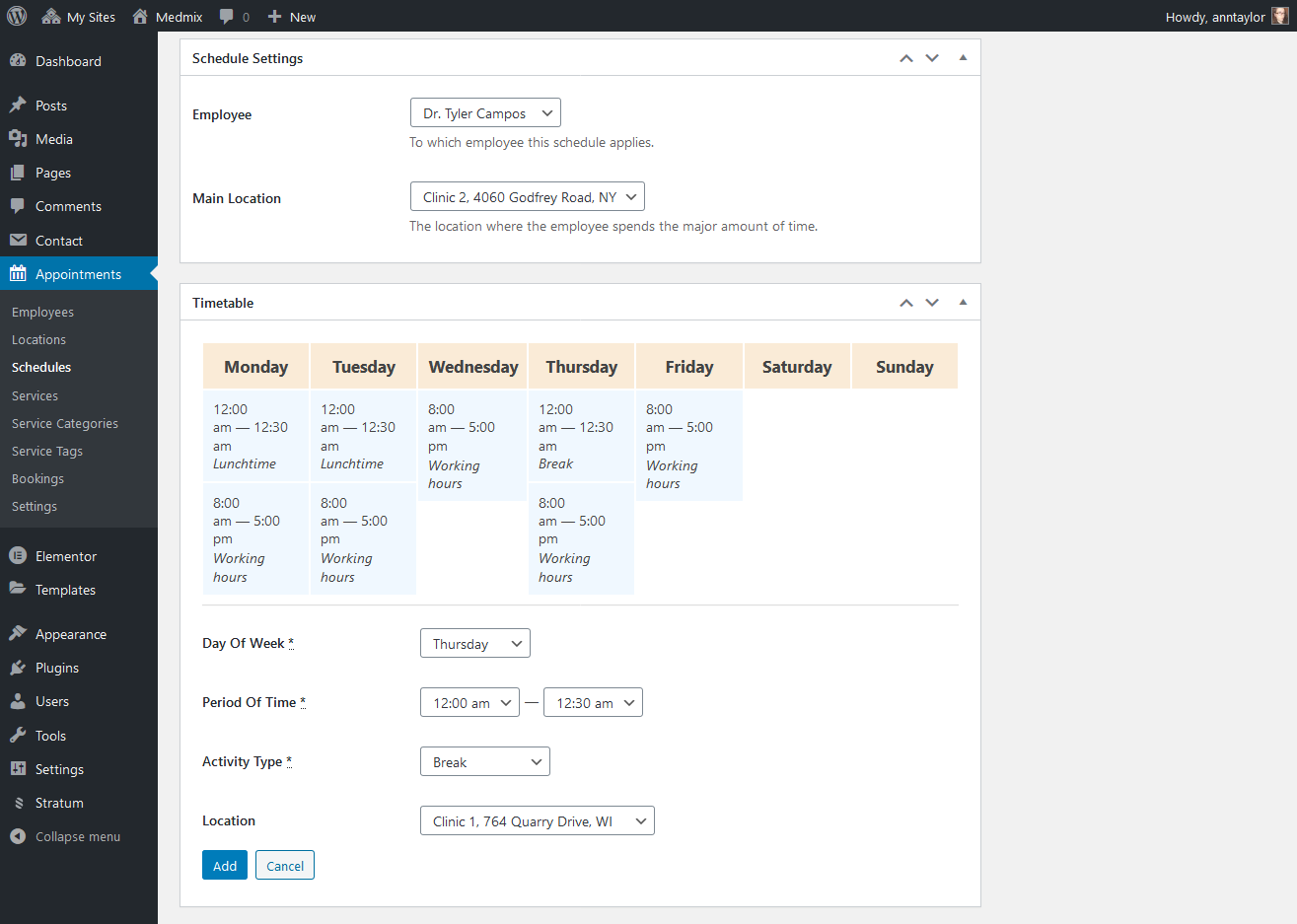
Easy and Convenient Booking Wizard
To simplify the booking process and ensure that appointments are successfully scheduled, unlike instances where potential customers struggle with the reservation procedure, Medmix incorporates a responsive booking wizard (provided by the Appointment Booking plugin).
The tool guides patients through a three-step process: selecting a service, optionally choosing a specific doctor or location, picking the date and time, and providing personal information. This user-friendly feature streamlines the reservation process, thereby enhancing the overall user experience. So, your website should offer a similar capability too.
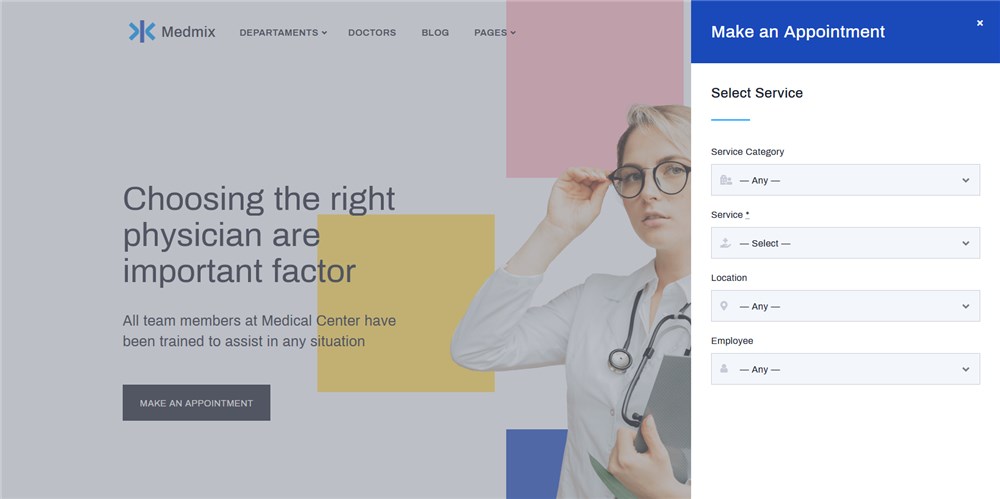
Online Payment Processing
When a customer wishes to pay the bill before visiting, during the booking process, it’s essential to offer this opportunity. Although a person might choose on-site payment for the first visit due to initial concerns, after having a positive experience with your clinic, they may be more inclined to make payments online for subsequent visits.
Moreover, you could incentivize this process by offering special discounts for online payments, which could also benefit your clinic with a quicker cash flow. Regarding our example, Medmix facilitates online payment processing through gateways like PayPal and Stripe, while also offering direct bank transfers.
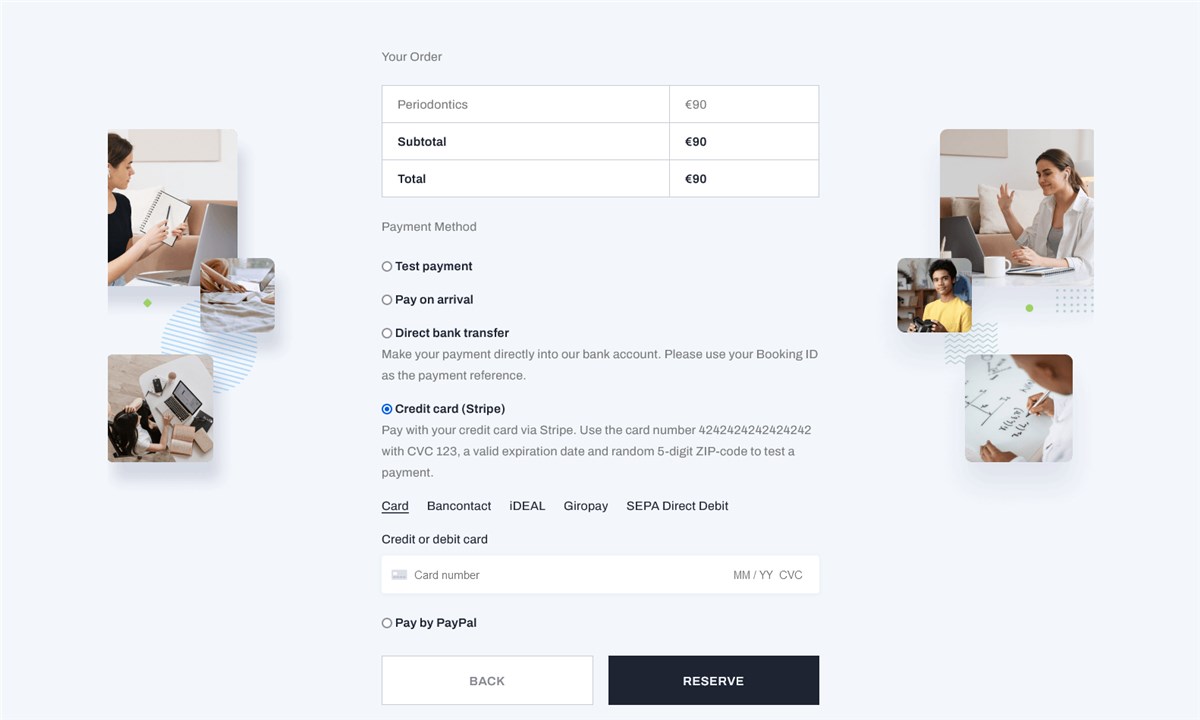
Appointment Reminders
Implementing automated systems to send personalized appointment reminders can significantly reduce no-show rates. These reminders, sent via email, SMS, or phone calls, can include the patient’s name, appointment date, time, and practitioner’s name, making the communication more personalized and informative.
Our exemplary template is equipped with automated email capabilities to send notifications to both staff and clients regarding booking status. This feature ensures that all parties are well-informed about appointment schedules, changes, or cancellations, which is crucial for improving a patient retention rate.
Payments and Client Management
An essential feature for the successful operation of a medical-related business is the ability to manage appointment bookings, payments, and all other necessary aspects of your establishment’s functioning.
For example, Medmix provides tracking of financial transactions and maintains a well-organized database of customer information, which is pivotal for effective management and compliance with healthcare regulations. This is what the dashboard page responsible for bookings management looks like for our healthcare template:
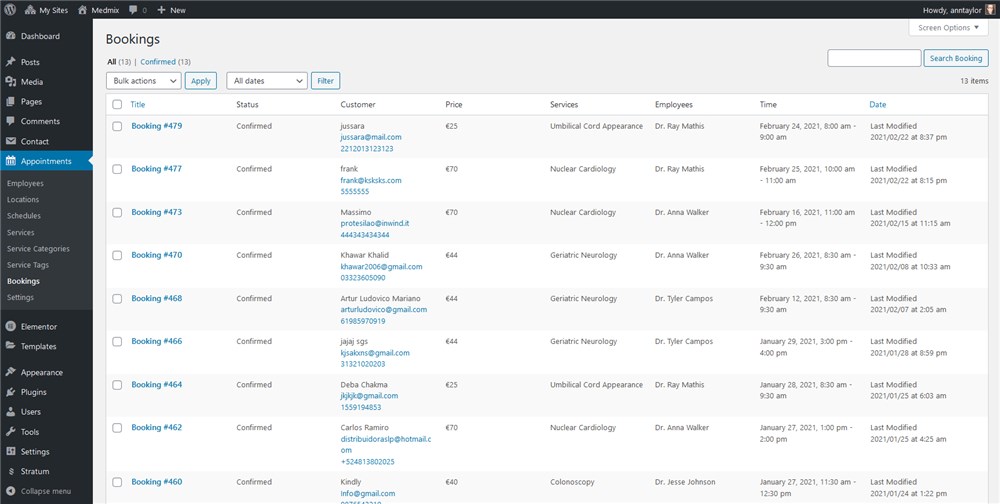
Overall, if you want to learn more about Medmix, a prime example of a WordPress template that facilitates the creation of a professional and fully-featured medical website, please review this video:
Medmix WordPress theme for Clinics Demo of Medmix Appointment Booking plugin
Which Optional Features Are Also Worth Considering to Improve Patient Retention Rate?
Apart from the functionalities mentioned above provided by the Appointment Booking plugin by MotoPress, there are also other additional capabilities worth considering to enhance the functionality of your medical website, and consequently, to improve the patient retention rate. They are listed below.
Post-Appointment Follow-ups
Following up with customers after their appointments is crucial for both gathering feedback and ensuring that they are on the right track with their treatment plans. Automated follow-up messages that inquire about the patient’s well-being, understanding of the treatment plan, and satisfaction with the service can help in building a lasting relationship.
Medication Reminders
Automated medication reminders are essential, especially for individuals with chronic conditions or those on complex medication regimes. Personalized notifications can help ensure adherence to medication schedules, improving treatment outcomes and consequently demonstrating your concern for the patient’s well-being.
Virtual Consultations
Offering virtual consultations through secure video conferencing platforms can provide convenience, save time, and ensure continuous care when in-person visits are not possible. This type of service is generally called telemedicine, and it will be discussed in more detail in the subsequent sections.
By integrating these technological strategies, healthcare practices can ensure a higher level of personalized communication. This fosters trust, boosts satisfaction, and contributes to an improved patient retention rate — vital for the sustainability and growth of your business.
3. Optimize Patient Experience During Waiting Times
Besides feeling understood, people will undoubtedly appreciate small comforts during their wait in the lounge and during their consultation with the doctor. That’s why elements such as relaxing music or candies at the reception are important: they serve as another example of the most effective patient retention strategies.
Taking a cue from shopping malls, for instance, there has been research suggesting that the aroma of fresh bread can boost sales. Thus, these comfort-related activities and sometimes subtle aspects can play a significant role in not only turning your clients into returning customers but also in potentially increasing sales figures when applied wisely.
Creating a Comfortable Environment
The moment a person steps into your healthcare facility, the journey towards creating a comforting atmosphere begins. Ensure the reception area is clean, well-lit, and inviting. The choice of comfortable seating, soothing colors, and a tranquil atmosphere significantly impacts a patient’s level of comfort:
- A pleasant ambiance with soft music, neutral colors, and clean surroundings can make customers feel at ease.
- Ensure that consultation rooms provide privacy and are soundproof to a reasonable extent, allowing patients to discuss their health concerns openly.
- Provide informative materials such as brochures or magazines related to health and wellness for people to read while waiting.
Reducing Wait Time
Long wait times can be a source of frustration for customers. Implement strategies to reduce wait times and keep patients informed if delays are unavoidable:
- We have already recommended using an appointment scheduling solution to streamline the process and ensure that appointments are spaced out appropriately to prevent overcrowding. Here, we merely reiterate the importance of this aspect in providing comfort for people.
- Keep people informed about expected wait times through SMS or email notifications. If delays occur, communicate this promptly.
- Streamline operations to reduce the time customers spend waiting. This could include having sufficient staff on hand to manage patient flow and ensuring that all necessary supplies and equipment are readily available.
4. Providing Exceptional Customer Service
When individuals feel valued and well-cared for, they are more likely to return and recommend your practice to others. This section explores two vital components that contribute to outstanding interactions: training staff for patient-centric engagements and effectively handling patient complaints.
Training Staff for Patient-centric Service
Earlier, we discussed the importance of appropriate behavior from the doctor’s side. However, the same holds true for assistants, nurses, receptionists, and other staff members. Training your workers to embody these values is crucial for delivering exceptional customer service:
- Implement ongoing training programs to keep your staff updated on best practices for patient care and communication. Or, at least, consider conducting periodic exams to ensure that their skill levels remain consistently high.
- Encourage staff to practice empathy, listen to customers attentively, and address their concerns with understanding. Maintain a high level of professionalism at all times, ensuring that interactions are courteous, respectful, and helpful.
Handling Patient Complaints Effectively
Addressing complaints promptly and effectively is a testament to your commitment to providing excellent service:
- Maintain open channels of communication for customers to voice their concerns. Be approachable, and ensure that people know how to reach out with complaints.
- Address complaints promptly. Acknowledge the issue, apologize when necessary, and take steps to rectify the situation.
- Use feedback from complaints as a learning opportunity. Analyze recurring issues and implement changes in your operations to prevent similar complaints in the future.
5. Offering Competitive Pricing
While the importance of this point largely depends on the sub-niche you operate in (for instance, it may be less crucial for clinics serving premium clients), it’s generally wise to assess competitors’ pricing policies. If possible, provide a comparable or even more advantageous cost in your clinic, but without sacrificing other aspects.
Offering competitive pricing, while maintaining a high standard of care, can significantly enhance patient retention rate. This section focuses on two pivotal aspects of pricing — transparency and the provision of flexible payment plans and options.
Pricing Transparency
This is about being upfront with patients regarding the costs they will incur for services rendered. This helps in building trust and setting clear expectations from the onset:
- Provide a detailed breakdown of costs for each service, including any additional fees that may apply.
- Consider displaying standard pricing for common services on your website to allow potential patients to gauge affordability before scheduling an appointment.
- Ensure that all communications regarding pricing are clear and straightforward to prevent any misunderstandings or surprises.
Payment Plans and Options
Providing flexible payment plans and multiple payment options can alleviate financial stress for patients, making healthcare more accessible and encouraging return visits:
- Offer payment plans that allow patients to spread out the cost of their treatment over a period of time, making healthcare more affordable on a tight budget.
- Accept a variety of payment methods including cash, credit/debit cards, and insurance to cater to different patient preferences.
- Offer assistance with insurance billing, helping people to understand what is covered and what their financial responsibility will be.
6. Implementing a Patient Loyalty Program to Increase Patient Retention Rate
Another example of patient retention strategies is the implementation of loyalty programs. These incentives help in continuous engagement and can be a cornerstone in retaining customers over the long term. They can be structured to offer rewards and special discounts, thereby cultivating a mutually beneficial relationship between the healthcare provider and his customers.
Rewards for Continuous Engagement
Providing incentives for ongoing interaction can promote repeat visits while creating a sense of appreciation and recognition. Here are some suggestions on how to structure incentives for ongoing interaction:
- Implement a point system where patients earn points for each visit, which can later be redeemed for services or discounts.
- Create membership levels based on the frequency of visits, with each level offering increased benefits, such as priority scheduling or discounts on services.
- Offer bonuses to customers who refer others, promoting a community of continuous engagement.
Special Discounts for Loyal Patients
Offering particular price reductions to devoted customers serves as a tangible expression of gratitude for their ongoing support. Here’s how such price reductions can be organized:
- Provide discounts on services for loyal patients, ensuring they see the financial benefit of their loyalty.
- Create exclusive offers for loyal customers, such as discounted rates on new services or special packages.
- Offer discounts or special deals on a patient’s birthday or the anniversary of their first visit as a personal touch to show appreciation.
7. Providing Quality Healthcare
While previous sections discussed general marketing strategies and polite behavior, we have now arrived at the cornerstone of any successful medical practice: the provision of quality healthcare. Patients seek out and return to medical establishments where they feel confident in the level of medical care they will receive.
Maintaining Rigorous Standards of Healthcare
Upholding exemplary standards in this aspect not only satisfies patients but also fulfills legal and ethical responsibilities. Below are the key facets of achieving such excellence, resulting in the enhancement of the patient retention rate:
- Ensure strict adherence to established medical guidelines and protocols to ensure the safety and well-being of patients.
- Utilize up-to-date medical equipment and maintain clean, well-organized facilities to provide effective treatment and a pleasant experience.
- Ensure thoroughness in diagnosis and treatment, taking the time to understand each patient’s unique health situation and providing a tailored care plan.
Continuous Improvement and Training
The medical field is ever-evolving with new discoveries and advancements. Staying abreast of these changes and fostering a culture of continuous learning is paramount. Here’s how:
- Conduct regular training sessions for medical and administrative staff to update them on the latest medical advancements and customer service best practices.
- Establish feedback loops with patients and staff to identify areas of improvement, and act on this feedback to enhance service delivery.
- Encourage and support staff in their professional development endeavors, such as attending conferences or pursuing further certifications.
8. Utilizing Patient Feedback
While we touched on the necessity of this matter previously, we have dedicated a separate section to underline its importance. Incorporating customer feedback is a pivotal step toward improving the overall customer experience and, by extension, patient retention rate. It offers invaluable insight into the patient’s perspective and helps in understanding the areas where your practice excels or can be significantly improved.
How to Collect Care Recipient’s Feedback
Gathering input from your customers should be an ongoing, structured process rather than a one-off event. Here are some strategies to do this efficiently:
- Provide feedback forms at the end of each visit, ensuring they are simple and quick to fill out. As mentioned earlier, you can offer bonuses or points to encourage individuals to complete these forms.
- Utilize online survey tools to gather feedback from patients post-visit. This can be done via email or through your practice’s online portal.
- Monitor and encourage reviews on social media and online review platforms. It’s a modern and convenient way for people to share their experiences.
- Consider forming a patient advisory board to get in-depth feedback and suggestions.
Making Improvements Based on Feedback
Once feedback is collected, it’s crucial to analyze it and implement changes wherever necessary. Here’s how:
- Look for recurring themes in the feedback to identify areas that need improvement.
- Not all input will result in changes; prioritize comments that align with improving patient care and experience.
- Make necessary adjustments in your practice based on the critique. This could range from small changes in office decor to significant modifications in medical care protocols.
- Inform your customers about the changes made based on their feedback, showing that you value their input and are committed to improving their experience.
9. Engaging Patients in Health Education to Increase Patient Retention Rate
Educating individuals about their health conditions and preventive measures is a crucial aspect of fostering a better patient-practitioner relationship and improving patient retention rate. When well-informed, they are more likely to engage actively in their healthcare, leading to better outcomes and satisfaction.
Providing Resources for Patient Education
Offering clear, understandable, and accessible educational resources can empower patients, making them feel more in control of their health. Here are some strategies:
- Create a section on your website where people can find articles, videos, and other resources related to their conditions or general health.
- Offer brochures, pamphlets, or booklets that people can take home. These materials can cover a range of topics related to the services you provide, common conditions, or preventive care measures.
- Regularly send out newsletters with health tips, updates on your practice, and information on common health issues. This not only educates but also keeps your practice in the minds of your patients.
- If possible, it’s a good idea to tailor educational materials to each individual’s unique health needs, which can be shared during visits or via email.
Organizing Health Workshops and Seminars
These types of events provide an interactive platform for people to learn and ask questions. They also offer an opportunity for your practice to showcase its expertise and care philosophy:
- Host workshops on various health topics, where your practitioners can provide advice, answer questions, and interact with patients in a less formal setting.
- Partner with local community centers or other healthcare providers to organize larger seminars. This can also help in reaching a wider audience and establishing your practice in the community.
- Online webinars serve as a convenient alternative for individuals unable to attend in-person events, offering a platform where individuals can interact with your practitioners from the comfort of their homes.
- Promote your events through your website, social media, and email to ensure a good turnout. Make sure to provide clear information on the topics that will be covered and the benefits of attending.
10. Expanding the Scope of Provided Services
A wide range of services offered by a healthcare facility is also one of the most effective patient retention strategies. When individuals know they can have their diverse needs met in one place, they are more likely to return.
Besides medical consultations, facilities often offer diagnostic services, medical procedures, and even medication sales. Additionally, partnerships with other establishments can be formed to exchange referrals: for instance, you might recommend a partner for surgical services, while they, in return, might recommend your clinic for prenatal care.
Providing a Variety of Services for Patient Requirements
Broadening the range of healthcare services can address a wide spectrum of customer needs, transforming your medical facility into a comprehensive solution. Here are some approaches:
- Offer a variety of services that encompass common healthcare needs. This could include general practice, dental care, physical therapy, mental health services, and specialty care.
- Providing on-site diagnostic services such as blood tests, imaging, and other essential diagnostic procedures can offer convenience and quicker results to patients.
- Incorporate telemedicine services to cater to individuals who prefer remote consultations or are unable to visit the clinic. This modern option is becoming increasingly expected by patients. Moreover, according to some evaluations, this sector is anticipated to grow tremendously in the following years, especially after the onset of COVID-19. There are even companies that focus exclusively on telemedicine services without offering in-person visits.
- Providing services outside standard business hours can cater to patients with different schedules, showing an understanding and accommodation of their lifestyle demands.
Partnership with Other Healthcare Providers
Establishing partnerships with other sector representatives can extend the range of services offered without the need for substantial investments in new equipment or staff training. Here are some ideas:
- Create a network of trusted healthcare providers to whom you can refer your customers for specialized treatment. Ensure these institutions share your commitment to patient-centered care.
- Share facilities with other healthcare providers to offer a one-stop healthcare solution. This arrangement can also foster a multidisciplinary approach to patient care.
- Collaborate with community health centers, pharmacies, and other local healthcare providers to create a seamless healthcare experience for patients.
11. Marketing and Patient Outreach
Effective marketing and patient outreach are essential aspects for not only attracting new customers but also for retaining existing ones. By showcasing your healthcare facility’s services, success stories, and community involvement, you can build a strong brand reputation and foster a sense of belonging among your patients, improving the patient retention rate as a consequence.
Utilizing Social Media and Online Marketing
Having a strong online presence is crucial for any healthcare facility aiming to retain its patient base. Here are some strategies to leverage online marketing and social media platforms:
- Create and share informative content related to healthcare topics on your website and social media platforms. This can position your facility as a trusted resource for health information.
- Share success stories to showcase the quality of care and positive outcomes achieved at your facility. This can foster trust and encourage other people to continue their patronage.
- Encourage satisfied customers to leave reviews and testimonials on online platforms like Google My Business and Healthgrades. Positive reviews can significantly impact the decision-making process of prospective patients and reassure existing ones.
- Utilize SEO strategies to improve your healthcare facility’s visibility online, making it easier for people to find and contact you.
Community Outreach and Collaboration
Engaging with the community can create a positive image and foster a deeper connection with your customer base. Here are some community outreach and education strategies:
- Participate in or organize community health fairs and offer free screenings. This not only provides valuable service to the community but also showcases your commitment to public health.
- Collaborate with local schools to provide health education, vaccinations, or screenings. Engaging with the younger population can also foster long-term relationships with families.
- Offer space for support groups or host meetings for individuals dealing with specific health conditions. This can create a supportive environment and provide additional resources for your patients.
- Partner with local businesses, gyms, or wellness centers to offer discounts or wellness programs to your customers. Local partnerships can extend the reach of your healthcare facility and provide added value to your patients.
Through a combination of online marketing and community engagement, your healthcare facility can foster a stronger connection with your customer base, enhancing satisfaction and encouraging long-term retention.
Conclusion: How to improve patient retention in healthcare
Providing excellent healthcare services is the cornerstone of a successful medical practice, but ensuring that people continue to choose your facility for their healthcare needs requires a strategic approach. This article has outlined several key strategies aimed at enhancing the patient experience, fostering trust, and ultimately, increasing patient retention rate. As we conclude, we’ll recap the essential strategies discussed and encourage healthcare providers to implement these practices for a sustainable and thriving healthcare practice.
Recap of Key Strategies to Enhance Patient Retention Rate
- Personalized Communication: Establishing a rapport with patients through personalized and respectful communication.
- Technology Utilization: Employing digital solutions for appointment scheduling, reminders, and follow-ups.
- Enhancing the Pre-Visit Experience: Creating a comfortable environment and reducing wait times.
- Exceptional Customer Service: Training staff for customer-centric service and effectively handling patient complaints.
- Competitive Pricing: Offering pricing transparency and flexible payment plans.
- Loyalty Programs: Rewarding continuous engagement and offering special discounts for loyal customers.
- Quality Healthcare: Maintaining high medical care standards and continuous staff training.
- Patient Feedback: Collecting feedback and making improvements based on patient suggestions.
- Health Education: Engaging people in health education through online or printed resources and organized events.
- Comprehensive Service Offering: Broadening healthcare services to encompass common needs and forging partnerships with other healthcare providers for a holistic patient care experience.
- Marketing and Outreach: Utilizing online marketing and engaging in community outreach for comprehensive patient outreach.
The journey towards enhanced patient loyalty is a continuous process that requires a committed effort from the entire healthcare team. By focusing on exceptional service, engaging with those you serve, and proactively addressing their needs and concerns, healthcare facilities can establish a loyal base, which, consequently will lead to high levels of patient retention rate.
We encourage healthcare providers to take proactive steps in implementing these strategies, continuously evaluate the results, and make necessary adjustments to ensure that your medical facility remains a preferred choice for patients.

